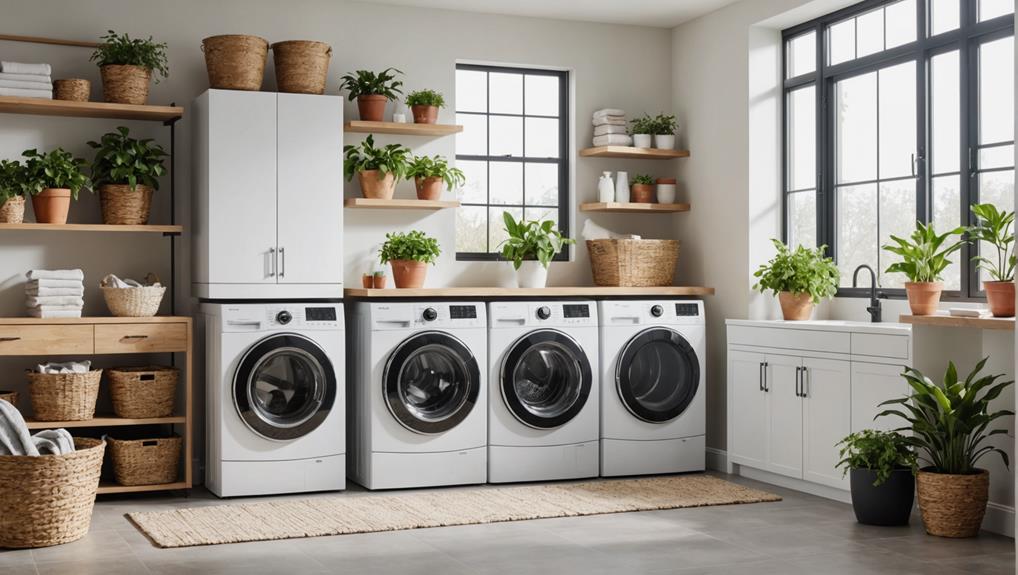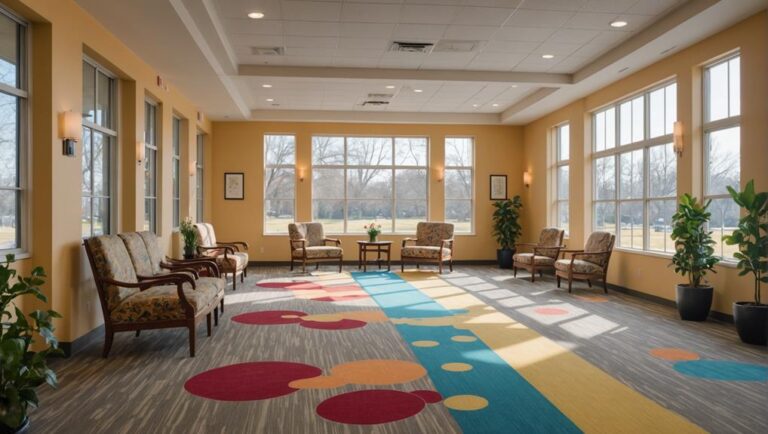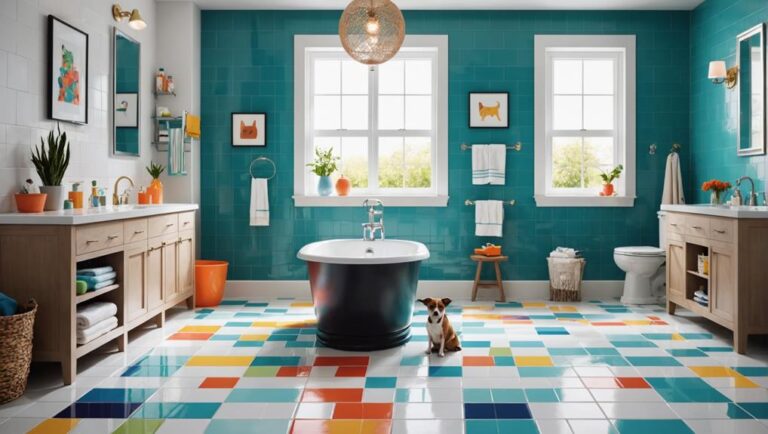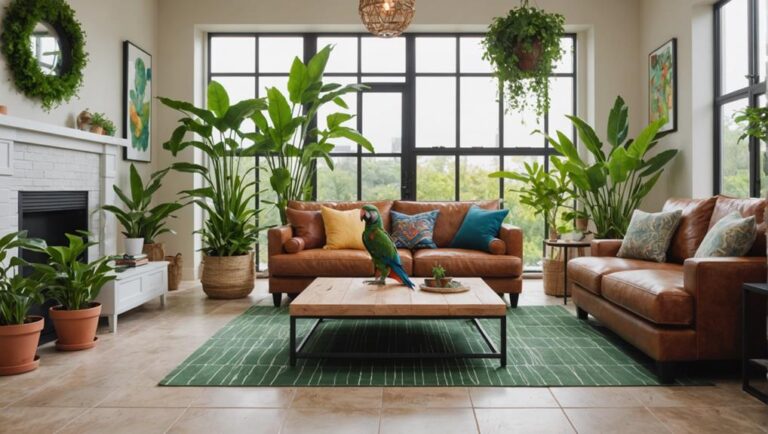For moisture-resistant floors in laundry areas, consider options like vinyl planks, ceramic tiles, or luxury vinyl tiles. These materials resist water and help prevent mold growth and structural damage. Proper installation is key—ensure the subfloor is clean and level, and adhere to manufacturer guidelines regarding adhesives and expansion gaps. Maintenance involves regular cleaning and addressing spills immediately to avoid damage. Additionally, using suitable protective coatings will enhance moisture resistance. With a variety of styles available, you can create both functional and visually appealing spaces. There's even more to explore about optimizing your laundry area's flooring options.
Importance of Moisture Resistance
When it comes to designing laundry areas, moisture resistance is crucial. You need to understand that the combination of water usage and high humidity levels creates an environment where water damage can easily occur. This damage not only affects the floors but can also lead to mold growth, structural issues, and costly repairs. As a result, prioritizing moisture-resistant materials in your laundry area is critical for long-term safety and functionality.
Maintaining humidity control is essential in any laundry space. High humidity can lead to condensation, which further exacerbates the risk of water damage. Choosing the right flooring material, such as vinyl or tile, can greatly reduce moisture absorption and limit potential damage. These materials are designed to withstand spills and high humidity without warping or deteriorating.
Additionally, proper ventilation is an important consideration. Installing exhaust fans or ensuring windows can be opened will help regulate humidity levels, thereby protecting your flooring investment. Furthermore, integrating moisture barriers beneath your flooring can provide an extra layer of protection against water damage.
Top Flooring Options
Choosing the right flooring for your laundry area can greatly impact its durability and functionality, especially in a space prone to moisture. When evaluating flooring options, contemplate materials that offer both water resistance and durability to withstand the challenges often encountered in laundry spaces.
Here are some top flooring options to contemplate:
- Vinyl Planks: These are highly moisture-resistant and come in various designs, mimicking wood or stone. They're also easy to clean and maintain, making them ideal for busy laundry areas.
- Ceramic or Porcelain Tile: Known for their durability, these tile options are impervious to water and provide excellent protection against spills. They're also available in numerous styles and colors.
- Luxury Vinyl Tile (LVT): Similar to vinyl planks, LVT offers an upscale appearance while maintaining moisture resistance. Their cushioned surface can be more comfortable underfoot.
- Sheet Vinyl: This seamless option reduces the risk of water seeping through seams, making it a great choice for full coverage in laundry rooms.
- Epoxy Coatings: If you're looking for a more industrial finish, epoxy coatings applied over concrete can create a moisture-proof surface that's easy to clean.
Installation Considerations
Proper installation is essential for guaranteeing the longevity and performance of moisture-resistant flooring in laundry areas. To achieve this, start with thorough subfloor preparation. The subfloor must be clean, dry, and level. Any debris, moisture, or imperfections can compromise the integrity of your flooring. If you're working with a concrete subfloor, check for any cracks or moisture issues, addressing them before proceeding.
Once the subfloor is ready, plan your flooring layout carefully. Measure the space accurately and determine the direction in which you'll lay the flooring. Aligning the planks or tiles with the room's longest wall or primary light source can enhance the aesthetic appeal and visual flow. Additionally, guarantee that you leave adequate expansion gaps along the walls, as moisture-resistant materials can still expand and contract with changes in humidity and temperature.
When installing, follow the manufacturer's guidelines meticulously. This includes recommended adhesive, if applicable, and necessary underlayment to further mitigate moisture risks. If you use a floating floor system, make sure to secure the pieces according to the specified method to prevent movement.
Maintenance Tips
Moisture-resistant flooring in laundry areas requires consistent maintenance to guarantee its durability and functionality. Establishing effective cleaning routines is vital in preventing the accumulation of dirt and moisture, which can compromise your flooring's integrity over time. Regular maintenance not only enhances the appearance of your floors but also guarantees a safe environment.
Here are some essential maintenance tips to keep in mind:
- Regular Cleaning: Sweep or vacuum the floor weekly to remove dust and debris. Follow this with a damp mop using a suitable cleaner to minimize moisture exposure.
- Immediate Spill Response: Address spills promptly to prevent staining and water damage. Use a soft cloth to blot, avoiding aggressive scrubbing that could damage the surface.
- Inspect Protective Coatings: Periodically check the protective coatings on your flooring. If they show signs of wear, think about reapplying them to maintain moisture resistance.
- Avoid Harsh Chemicals: Use pH-balanced cleaners specifically designed for your flooring material. Harsh chemicals can degrade protective coatings and lead to premature wear.
- Temperature and Humidity Control: Maintain a stable indoor environment by using dehumidifiers or proper ventilation to minimize moisture levels.
Design Aesthetics and Trends
When designing a laundry area, aesthetics play an essential role in creating a functional yet inviting space. You'll want to take into account both color palettes and texture combinations that not only enhance the visual appeal but also guarantee safety and durability. Selecting the right moisture-resistant flooring can complement your design while providing a secure surface.
Here's a quick reference table to help you choose suitable color palettes and texture combinations for your laundry area:
| Color Palette | Texture Combination | Safety Feature |
|---|---|---|
| Soft Neutrals | Matte Finish | Slip-resistant surfaces |
| Bold Accents | Textured Vinyl | Cushioned underfoot |
| Earthy Tones | Wood-Look Laminate | Durable and easy to clean |
Incorporating soft neutrals can create a calming atmosphere, while bold accents can energize the space. Textured vinyl offers a stylish look with added grip, reducing the risk of slips in wet conditions. Additionally, wood-look laminate combines aesthetic appeal with the practicality of moisture resistance.
It's crucial to remember that your laundry area doesn't have to compromise on style for safety. By thoughtfully selecting color palettes and texture combinations, you can create an inviting environment that meets both your aesthetic desires and safety requirements. As trends evolve, stay informed about new materials and designs that enhance both functionality and style in your laundry space.
Frequently Asked Questions
Can Moisture-Resistant Floors Reduce Laundry Room Odors?
Yes, moisture-resistant floors can greatly aid in odor prevention within your laundry room. By providing mold resistance, these floors help minimize the conditions that lead to unpleasant smells and the growth of harmful mold. When you choose the right materials, you're not just enhancing the aesthetic appeal of the space; you're also prioritizing your health and safety. Proper maintenance, alongside moisture-resistant flooring, creates a fresher environment that's free from unwanted odors.
Are There Any Eco-Friendly Moisture-Resistant Flooring Options Available?
Yes, there are eco-friendly moisture-resistant flooring options available. Bamboo flooring is a sustainable choice, as it's harvested from fast-growing plants and has natural moisture resistance. Additionally, cork tiles are another great option; they're made from the bark of cork oak trees and offer excellent water resistance while being biodegradable. Both materials not only help reduce your environmental impact but also provide a safe, stylish solution for moisture-prone areas in your home.
How Do Moisture-Resistant Floors Impact Home Resale Value?
Isn't it true that certain flooring materials can either elevate or diminish your home value? Moisture-resistant floors can greatly enhance your home's resale potential, as they showcase durability and practicality, especially to prospective buyers concerned about safety and maintenance. By investing in quality moisture-resistant options, you're not just protecting your space from water damage; you're also making a wise decision that can positively impact your overall home value in the market.
What Is the Average Cost of Moisture-Resistant Flooring per Square Foot?
The average cost of moisture-resistant flooring typically ranges from $2 to $8 per square foot, depending on the material. For a cost comparison, consider vinyl, laminate, or tile, as they vary greatly in price and durability. When installing, guarantee proper underlayment to enhance moisture protection and longevity. Always follow manufacturer guidelines for safety during installation, and remember that investing in quality materials can save you money in repairs down the line.
Do Moisture-Resistant Floors Require Special Cleaning Products?
Imagine a pristine surface, glistening like morning dew—this is what your floors could be. When it comes to cleaning moisture-resistant floors, you don't need special products. Standard cleaning methods usually suffice, but avoid harsh chemicals that might damage the finish. Regular maintenance tips include sweeping or vacuuming to remove debris and using a damp mop with mild detergent. This approach keeps your floors safe and looking their best without unnecessary wear.




